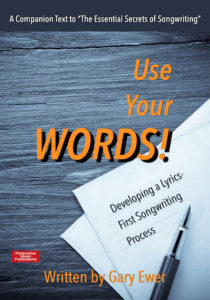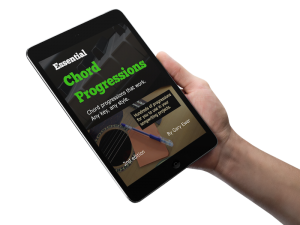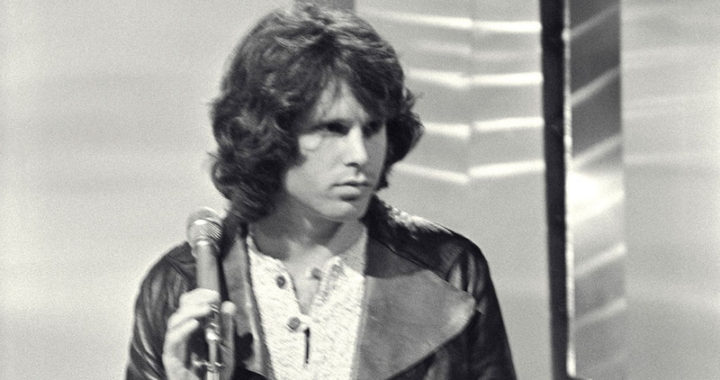We know from looking at decades of songs in the pop genres that the songs that really resonate with us and make us feel strong emotions are the ones that shift back and forth between sections of lower and higher emotions.
 “Use Your Words! Developing a Lyrics-First Songwriting Process” is FREE with your purchase of “The Essential Secrets of Songwriting 10-eBook Bundle. $37 USD. Immediate Download.
“Use Your Words! Developing a Lyrics-First Songwriting Process” is FREE with your purchase of “The Essential Secrets of Songwriting 10-eBook Bundle. $37 USD. Immediate Download.
Classic rock songs show this easily, like for example, The Doors’ “Light My Fire” The verse sets the scenario:
You know that it would be untrue
You know that I would be a liar
If I was to say to you
Girl, we couldn’t get much higher.
It’s what you’d expect from a typical love song. But you’ll notice that the emotional level of those words doesn’t rise much above being narrative in style, describing a situation: “There’s no way our love for each other could get much better.”
Then the chorus takes things to an emotional high:
Come on baby, light my fire
Come on baby, light my fire
Try to set the night on fire.
…which doesn’t add much to the implied story. Its main job is to heighten emotion.
For the rest of the song, we see this alternating between verse lyrics that are sweet but limited in their emotional expression, followed by that much more emotional “Come on, baby” chorus.
That back-and-forth is a pattern we see with so many of the world’s best songs.
So what about songs that use a bridge, which typically occurs after the second go-through of the chorus?
It depends on the musical energy of the song up to that point, but in many cases, the bridge is a section where the emotions fluctuate from line to line. I like using the bridge of Taylor Swift’s “You Belong With Me” as a textbook example of this kind of fluctuation:
Oh, I remember you driving to my house
In the middle of the night
I’m the one who makes you laugh
When you know you’re ’bout to cry
I know your favorite songs
And you tell me about your dreams
Think I know where you belong
Think I know it’s with me
The first two lines (“Oh, I remember…”) read like lines from a story, while the next two are meant to dig in and pull out a deeper emotion from the listener (“I’m the one who makes you laugh…”)
As I say, it’s a textbook example, but many songs do this. A good song will take that gradual shift from narrative to emotional that happens between verse and chorus, and then speed up the pacing of it so that it happens almost line by line in the bridge.
Troubleshooting a Bridge
In most cases, that’s the main reason for a bridge: to heighten emotion. If most songs are about feelings (they are!), then the bridge needs to be a place where those emotions are most heightened.
Sometimes it’s the case where a song that exudes powerful emotions from start to finish, and a bridge can be a moment within such a song where things diminish emotionally, or where more gentle emotions are substituted for the more powerful ones.
But in any case, think carefully about what you want your song bridge to do for you. And it almost always comes down to playing with emotion.
 Written by Gary Ewer. Follow Gary on Twitter.
Written by Gary Ewer. Follow Gary on Twitter.
 Looking for lists of progressions you can use in your own songs? “The Essential Secrets of Songwriting” eBook Bundle has 2 main collections, plus eBooks on how to harmonize your own melodies, and more.
Looking for lists of progressions you can use in your own songs? “The Essential Secrets of Songwriting” eBook Bundle has 2 main collections, plus eBooks on how to harmonize your own melodies, and more.











Pingback: What Should Happen After a Song Bridge? | The Essential Secrets of Songwriting
Donna The Chorus is the place for the Summation of the story
The Bridge or a Middle 8 can add to the story told in the Verses,
as explained by GARY, The Bridge is an ideal place for a short
holiday and in some cases a temporary modulation away from the home key
and then returning giving contrast to the general notation of the melodies
of the songs Verses and Chorus
Hmm!! I had not really heard that before. I was always told the bridge was to add something different to the story, a twist, a summation of the story, an insight or different perspective, a moral statement. A place to reflect or pause. Maybe that’s what you mean a place for the listener to connect internally to the story.
Hi Donna:
All of the characteristics you mention are indeed parts of good song bridges, but I was talking about emotional content in this post. In other words, good bridges will add to a story, finish a story, or allow “the other shoe to drop.” But what the listener picks up more than anything is its emotional value. Connecting, at least as far as songwriting is concerned, is an emotional issue.
-Gary